
The 'Aerial Target' and 'Aerial Torpedo' in Australia
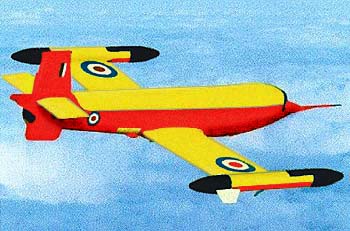 Jindivik
the spellings presented here are: Jindivik, Jindivic, Jindavic and JindavikFor the purposes of this paper, we will use the most commonly found spelling and the one which is actually correct, Jindivik, the aboriginal word for 'The Hunted One' which, as the Jindivik's is a target aircraft, seems quite an appropriate. (Ed.)
The Jindivik The Jindivik made its first flight, from the Australian test facility of Woomera, on October 31, 1950, and is the forerunner of the current unmanned target vehicle used by AGWOEU. The UK acquired a total of 267 examples and is now the only country using Jindiviks. They have been flown from the DERA operated airfield at Llanbedr in Wales since 1960, and the current examples are from the 700, 800 and 900 series. This latest version is capable of speeds in excess of 500mph (800km/h) and altitudes over 80,000ft (24,383m). Although other countries often convert full-size redundant aircraft to act as flying targets, the Jindivik is currently the only aircraft in everyday use by the RAF capable of regularly being exposed to, and surviving, live missile firings during simulated combat. This has not always been the case, as there are now only 31 airframes remaining from the original purchase of 267. Most of the 174 that were shot down fell during the 1960s and 1970s - since 1990 this 'kill' rate has been drastically curtailed, and currently averages 1.1 airframes per year, all by accident rather than by design. If required, perhaps for evaluation purposes of the incoming missile or other 'operational reasons', the Jindivik can be configured to carry a camera. The captured information can then be perused at the crew debrief or by development engineers. Flown by a five-man team on the ground operating via radio-command links, initial launch is made from a steerable trolley positioned on the runway at Llanbedr. This launch is carried out by an Azimuth Controller (located behind the runway threshold) and the Master Controller stationed in the Control Tower. The mission is flown by a 'Skipper' and 'Navigator' seated in a darkened control room where the full range of mission data is displayed via telemetry data transmitted from the Jindivik. Final approach and landing (on a skid lowered under the Jindivik on rejoining the circuit) is controlled by a Pitch Controller and the Azimuth Controller. For safety reasons, all Jindivik launches are accompanied by a DERA-operated manned aircraft (usually Hawk XX154), and in the unlikely event of a major drone malfunction, the 'chase' aircraft pilot can order the ground-initiated self-destruction of the Jindivik.
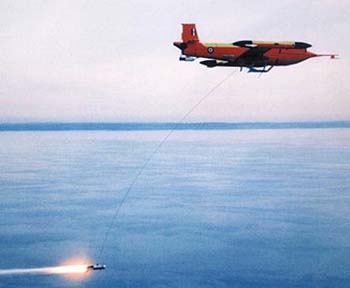 Jindivik trailing a flare
The Jindivik is powered by a Rolls-Royce Viper jet engine (also used by the BAC Jet Provost) and by design, most air-to air missiles lock onto a heat source to home onto their targets. A means of deflecting the incoming missile had to be devised to prevent the Jindivik from being destroyed every time it was flown. An onboard winch system was devised that could send out one of two infra-red flares on the end of a 200ft (61m) wire rope. The flare then becomes the hot target for the incoming heat- seeking missile. After the 'hostile' aircraft has expended its missile, the spent flare is wound in and the second flare is trailed out for a repeat performance. The Jindivik has now completed well over 7,000 operational sorties in the UK. Who said Unmanned Aerial Vehicles are a new creation?
GAF Jindivik Australia's most successful home grown aircraft, the Jindivik (Aboriginal for 'Hunted One') has been in production for five decades. Originally designed to a British specification for a high speed target drone, the Jindivik has grown to cover a large range of tasks including surveillance, target towing, and cruise missile simulation.
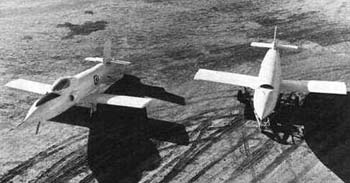 GAF Pika (left) and the Jindivik
The first example to fly on 4 November 1950 was the Pika manned proof-of concept vehicle. The Pika is the only manned jet aircraft to be designed and flown in Australia. Two were built, A93-1 being lost in an accident in April 1951. The sole remaining example is now at the Point Cook RAAF Museum. The first Jindivik flew in August 1952. Initial production ran from 1951 to 1986 with a total of 502 examples being delivered to Australia (182), Sweden (10), US (42), and Britain (268). The production line re-opened in 1997 when Britain ordered another 15 examples.
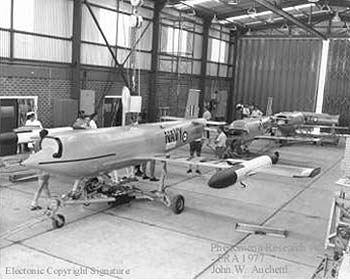
Jindivik Mk.203a, Royal Australian Navy Base http://members.nbci.com/_XMCM/praufo/prauav/jindivik203a.htm
'Targeting' at Llanbedr
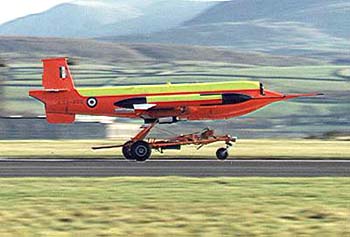 Jindivik leaving the launch vehicle
The Jindivik, an Aboriginal term meaning 'The Hunted One' UAV (Unmanned Air Vehicle), made its first UK flight April 1960 and its 7000th in early 1999. The Jindivik is used to carry towed Infra-Red and Semi-Active Radar Targets, and since its introduction, it has continued to be the standard weapons target in both Australia and the UK and has been the cornerstone of many missile development programmes. The attrition rate has been roughly 236 airframes since operations began, although two have been lost in the past year. It continues to be the primary aerial target for the exercise of the RAF fighter squadrons. Development of the drone has also continued throughout its lifespan, both in expanding the original flight envelope and in protecting this increasingly valuable target by using decoys for missile engagements. Originally conceived as a high-altitude aircraft, the introduction of a Radio Altimeter flying control system enabled it to be flown at very low levels over the sea. Development of a decoy system has also enhanced the overall realism of the target. The Jindivik is flown via a radio command link by a five-person team on the ground. Launch is from a steerable trolley on a conventional runway directed by a Take-Off controller who is located behind the take-off point. Recovery is directed by separate Pitch and Azimuth Controllers, and landing is accomplished using a skid extended below the drone. Throughout the mission, control is exercised from a two-person blind control cell, where the full range of flight and mission data is presented on instrument displays driven by telemetry data transmitted from the aircraft. The Master Controller exercises all-round supervision of the operation. Miss-distance cameras provide film records of the missile engagement for evaluation.
Cranfield Aircraft Design and Engineering Group The Jindivik is an unmanned target aircraft which is operated by DERA from Llanbedr airfield in North Wales. The Jindivik project office within CAe is the UK design authority for the aircraft, and CSG provides an important contribution to many of the design support activities undertaken by the Project Office. Recent examples include the design of a pyrotechnic sequence unit, design of instrumentation for data acquisition and recording for airborne trials to evaluate new equipment, and the provision of advice to external contractors regarding the interfacing of an avionic sensor. CSG also maintains a software simulation of the Jindivik aircraft, including its on-board flight control system which has been used both for design studies and as the basis of a Procedural Trainer for the aircraft operators.
Cranfield Aircraft Design and Engineering Group In 1989, contracts were let by MoD (PE) for Post Design and In-Service Support of the Jindivik Target Drone. These contracts were initially for a period of 3 years. Since that time, CAe has continued to support the aircraft operated by DERA and has amassed considerable knowledge and experience of the aircraft and its operational role, so much so, that CAe is now designated as the Design Authority for the aircraft following the decision by the aircraft manufacturer, ASTA, that it would not be continuing to support the aircraft. A dedicated project team has been established to manage the maintenance of Design Records, Fault Recording and Investigation, Maintenance of Technical Publications and the Introduction of Modifications. Modifications have been defined and incorporated to enhance the aircraft operation (onboard Target Video System), enhance the aircraft performance (Decoy Flare Dispensing) or to evaluate equipment being assessed for application to operational aircraft (Missile Approach Warner assessment) In addition, involvement with Jindivik has led to the development of towed targets, incorporating a range of enhancements, both IR and Radar, for application to Jindivik and to other aircraft.
When computers met reality . . . A novel first for trials was notched up recently when T&E Ranges demonstrated just how the real world could interact with a simulated environment. Experts, based at DERA Aberporth and Bedford, managed to combine a simulator and a Jindivik Unmanned Air Vehicle (UAV) in a trial that links the real world with that of a computer simulation.
Australian Space Commemorative Covers
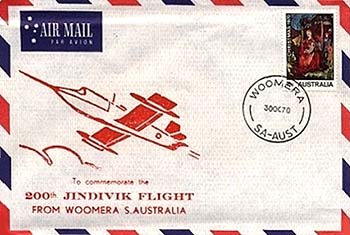 Jindivik commemorative cover, Oct 30, 1970
Woomera : Australian aboriginal native spear thrower The woomera increases the torque in the arm when throwing a spear since it in effect increases the length of the throwing arm. Because of this a woomera increases the speed of a thrown spear and increases the distance it will travel. A good woomera is indispensible when hunting game at a distance with a spear, including wallabies, emu, plain turkey, scrub turkey and geese. One end of a woomera has a hook which the butt of the spear hooks into. The other end often has two 'woomera shells' attached and fasted with 'bush wax' and perhaps decorated with 'giddee-giddee' beads.
Black Box to Black Hawk: Sixty Years of Aeronautical Research in Australia
Jindivik ARL's pioneering expertise in flutter and vibration analysis was successfully applied to Jindivik, an unmanned, jet-propelled target plane designed to measure missile performance. Between 1952 and 1997 Jindivik made $34 million in sales to Britain, Sweden and the US Navy.
Jindivik - Remote Piloted UAV
Flight Control System Design for Autonomous UAV Carrier Landing A Ph.D. Thesis by Pio Fitzgerald Title: Flight control system design for autonomous UAV carrier landing Authors: Cook, M. V. (Supervisor) Fitzgerald, Pio Issue Date: 18-Apr-2005 Publisher: Cranfield University, School of Engineering Abstract: The challenge of integrating the UAV fleet into the carrier landing operational structure with respect to navigation and control strategies is addressed. A simulation model was developed which includes an aircraft model, an atmosphere model and an aircraft carrier motion model. The six degree of freedom non-linear aircraft model is based on the aerodynamic characteristics of the Mk 4a Jindivik extended to include rudder, spoiler and thrust vectoring controls, and an undercarriage model. The atmosphere model includes a carrier landing atmospheric disturbance model. The six degree of freedom aircraft carrier motion model is based on the ship motion simulation program SEAWAY. A navigation system was developed which conforms to current operational procedures and future military navigation goals. This navigation system continuously predicts the position in space where touchdown on the carrier deck will take place, based on aircraft position, the relative velocity between the air... http://hdl.handle.net/1826/840 Appears in Collections: PhD Theses (School of Engineering)
More Jindivik Images
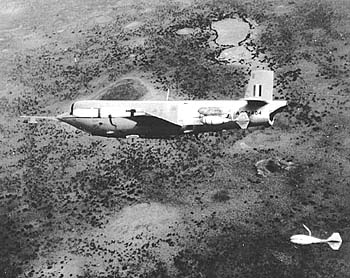 Jindivik and decoy, 1967
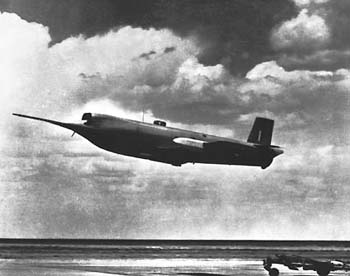 Jindivik on launch, 1967
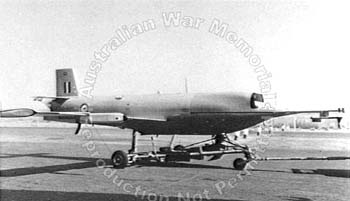 Jindivik
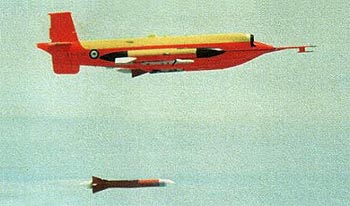 Jindivik
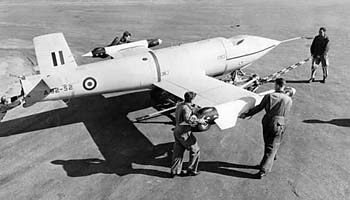 Jindivik being pushed on taxi-way before taking off, Woomera, South Australia. There are cameras in the wing tip pods.
The Argus Newspaper, Brindle, W., photographer. 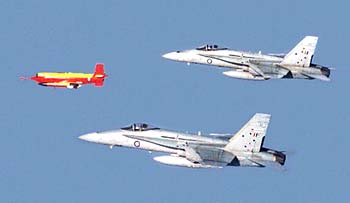 Jindivik and its two 'hunters' RAAF FA-18s
Technology in Australia 1788-1988 : The United Kingdom Australia Agreement For bilateral activities, Australia's open spaces and climate offered a natural venue for investigations of long range weapons so its government agreed to provide the sites, and to participate in the developments with Britain on a co-operative basis. Lieut. General J. F. Evetts and Mr (now Dr) W. A. S. Butement located a base site about 400 km north of Adelaide with a potential range area extending generally north west. A joint project agreement was signed in 1946. This led to the creation of the Long Range Weapons Research Establishment (LRWE). (In later years this became the nucleus from which the great and wholly Australian Weapons Research Establishment, WRE, at Salisbury arose.) Initially, the agreement provided for the United Kingdom to develop a series of guided missiles, and for Australia to develop the testing facilities and infrastructure. Also included in Australia's responsibilities was the development of unmanned target aircraft to be ultimately capable of supersonic speed. This project used the design facilities of the Government Aircraft Factory at Fisherman's Bend; under the direction of I. B. Fleming,[34] the successful Jindivik was produced, and eventually manufactured and exported. Other, less immediate projects of great importance were to be undertaken as the need arose. These are reported later. Increasing defence research activities pointed to the need for continuing review and policy advice to government. Dr A. P. Rowe was appointed as Defence Scientific Adviser, and became Chairman of the Defence Research and Development Policy Committee (later this was to be chaired by Sir Leslie Martin, and after reorganization by subsequent Chief Defence Scientists, H. A. Wills, Dr J. L. Farrands and Professor P. T. Fink). 34. Fleming, I. B. Thirty years later-Jindivik in retrospect. Aerospace, Vol 6, No 9. The Royal Aeronautical Society, November 1979.
ADF Aircraft Serial Numbers A92/N11 GAF Jindivik
GAF Jindivik Kit No 72003 is the rather interesting GAF Jindivik target drone, designed and built in Australia, and used either currently or in the past by the RAAF, the RAN, as well as the RAF in the UK, the US Navy, and the Swedish Air Force. The initial run of models has sold out but we have made a new mould which is somewhat cleaner than the earlier mouldings. Included in the kit is the launch trolley with white metal wheel assemblies and supports. Both the later forward opening (as illustrated) and early flush NACA type air intakes are included. When painted in its high- vis colours of Day-Glo Red and Day-Glo Yellow it is sure to stand out in any collection.
GAF Pika 72010 is the GAF Pika, and what is that you may well ask. Well, before the Jindivik (kit 72003) drone was flown, two manned proof- of- concept aircraft were built and tested at Woomera, thereby proving the aerodynamics, engine, and fully testing the radio control systems proposed for the Jindivik. For those Luftwaffe 1946 modellers this could be a continuation of your fantasies, as I believe Adolf Galland and others scored victories flying their little Pika Volksjagers..... Either way, what a conversation piece at your next competition. More images of the Pika
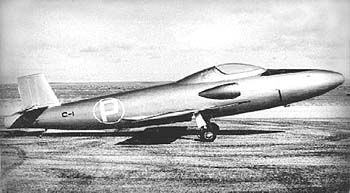 GAF Pika, (most likely at GAF), 1951
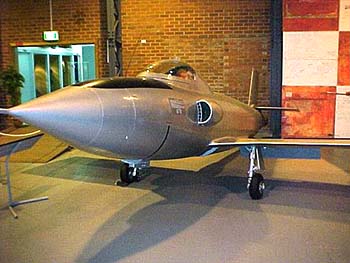 GAF Pika A93-2 at the RAAF Museum Point Cook
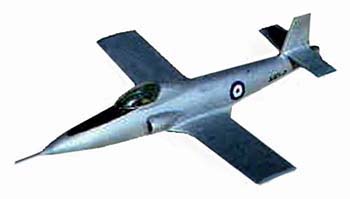 GAF Pika A93-2 (model kit) details tba
Further Reading
Fire Across the Desert In 1984 I was commissioned by the Federal Government to undertake this very large technical, political and social history - the largest scientific history ever published in Australia.The research and writing took me nearly four years. It is based on all the surviving documentation in Canberra, South Australia, Woomera, the Public Records Office Kew, London and Washington DC. I spent four periods in Britain working in Whitehall among many still-classified UK documents, for which I had a "top secret" security clearance from ASIO and MI5. Fire across the Desert is the authoritative account of the history of Woomera, the "space town" in South Australia, up to 1980. Its chapters deal with the social and domestic life of the Village over the years, as well as with the technical work at the Range. Because it uses documents not in the public domain, it also casts some surprising light on the political relations between Australia and the "Mother Country" in the post-war period. It is written in a semi-popular style and is designed to appeal to the interested layman as well as academic historians.
Jindivic
The Beverley Aeronautical Museum. WA.
Jindavic
The Woomera Heritage Park
Jindavik
A History of Woomera
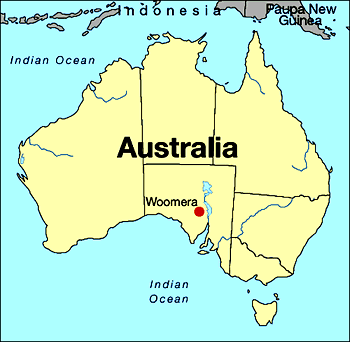 Woomera, Australia
Woomera came into existence as a consequence of Britain's defence requirements following World War II. It needed a large, remote area in which to test new weapons systems. Various sites were considered, including one in Canada. In the end, Australia's vast and virtually unpopulated inland won the day, and the Long Range Weapons Establishment (Woomera rocket range) came into existence on 1 April 1947 as a Joint Project between Britain and Australia. Woomera's history is one of weapons testing, satellite launches, and tracking of early lunar and planetary spacecraft, as well as the Mercury manned spacecraft. Highlights are listed below and other pages on this web site will give the history of various projects conducted at Woomera. ...more
Kalkara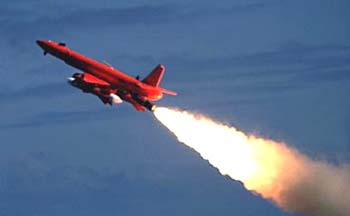 Kalkara http://www.shoal.net.au/~gib/jindavik.html
Kalkara Unmanned Aerial Vehicle http://www.boeing.com Boeing Australia Limited is responsible for the operation and maintenance of the Kalkara Unmanned Aerial Vehicle until May 2007, designed and developed as a general purpose pilotless target for the development of guided missile systems. Kalkara is an Aboriginal word meaning Storm Petrel and is being introduced by the Royal Australian Navy, replacing the Jindivik. The system being provided to the RAN includes the target aircraft, its ground control station, towed targets and related ground support and test equipment and is based at Jervis Bay in New South Wales. Boeing is responsible for the total in service support of the new system, including maintaining and repairing the system, preparing the vehicle for launch and controlling the target once airborne. The Kalkara is launched from a fixed launch stand and the primary launch feature is a rocket assisted take-off bottle, which is dropped after three seconds, allowing the drones' jet engine to take over and power the aircraft throughout the rest of the flight. Once the mission is completed, the aircraft is parachuted into the ocean and picked up by boat. It is then de-contaminated, checked and readied for the next flight. Each aircraft is expected to perform a minimum of 17 flights. The Kalkara carries a variety of payloads on wingtip and underwing mounts as well as towed targets. These include infra-red and radio frequency targets and countermeasure pods. All of these will be used for exercising both infra-red and radar guided missiles launched from RAN vessels and Royal Australian Air Force aircraft.
Kalkara at the Australian International Airshow, 2001 photo : Dr Russell Naughton
Kalkara at the Australian International Airshow, 2001 photo : Dr Russell Naughton
NASPO - Joint Project 7 - ADF Aerial Target System (Kalkara) http://www.dao.defence.gov.au Joint Project 7 is providing the Australian Defence Force with a cost effective aerial target system that requires minimal personnel to operate and maintain. The aerial target system is deployable to bare sites anywhere in Australia. Tracor (now BAE Systems) was selected as the preferred tenderer in December 1996 and has supplied twenty MQM 107E unmanned aerial vehicles, two Ground Control Stations as well as associated ground support equipment. Flight trials commenced in mid June 1998. A total of 33 flights have now been conducted. The Kalkara system is now operating from the Jervis Bay Range Facility on the East Coast and from HMAS Stirling (Garden Island, Western Australia) and in time will also conduct operations from other locations within Australia as required by Navy and Air Force units. Particular emphasis was placed on the issue of the environment and the sensitivity of proposed launch sites. Extensive consultation with local interest groups including: Governmental groups, local Government, traditional owners and other organisations has occurred.
Navy weapon training not quite on track In the next few weeks, (this was written in 1999 - Ed.) the Royal Australian Navy puts to sea for the first big training exercise of the year. The guns will be trained and the radar will guide missiles, but the shooting will be severely limited because the fleet's new unmanned target may not be ready for service. As recently as mid-January, the Canberra project office was still presenting the tiny, orange-red Kalkara target missile to the fleet but there continued to be teething troubles. This was about 14 months after the American-made Kalkara was due in service to replace the Australian Jindivik, which ended more than 35 years of service last June. Since then, the Australian fleet and other target users such as the fighter pilots of the Hornet squadrons have not had a target vehicle for honing their skills. Since June, the principal weapons officers have had to be content with tracking targets towed by civilian Learjets on lines up to nine kilometres long. (Other countries have been a bit more daring, shooting at targets streamed from aircraft on short lines. Unfortunately, some managed to shoot down the tow plane.) Learjets and Kiwi A-4 Skyhawk fighters based at Nowra are great as radar targets, beating up ships to provide tracking practice for the weapons. But when the cartridges start flying or the missiles zoom off the racks, an unmanned target is preferred by all. When the Jindivik was conceived in the 1950s, the miniature jet aircraft itself was the target. As missile accuracy improved, this became an expensive practice, so the engineers designed pods under the wings that would stream out what was called TONIC, which carried instrumentation to record how close the weapon came (a hit is unnecessary with a proximity warhead). The Jindivik was launched from a trolley and it used skids to land on an airstrip. Its performance went up from a single flight to 10, to 50 and eventually well into the hundreds (the record is claimed to be 324 flights). Gradually, the towed targets - tiny, cylindrical shapes packed with electronics to simulate hostile aircraft - became more and more "realistic" to the infra-red and radar sensors of ships and aircraft, and target making became quite a skill. The bean counters were happy when they realised it was possible to recover the Jindivik and the target, and they encouraged operators to let the targets fly well clear of the expensive bird - 2.4 kilometres was the rule for one of the targets. By the 1980s, it became apparent that the Jindivik's days were numbered. Because it was designed using 1950s technology, its control and guidance mechanism was the size of a washing machine compared with today's shoebox-sized gadget. It took a team of 18, some of them skilled pilots, to track and fly it. Its replacement needs six. So the decision was taken to buy the latest in target technology, preferably a robot aircraft that did not need a runway for launching (for use at Fleet Base West, HMAS Stirling, south of Fremantle in Western Australia). The project, designated JP7, called for expressions of interest and tenders in 1995. The tenders, which closed in January 1996, were for 20 aircraft to be in service by the end of 1997. Although the tender was not an especially big one, it drew six bids - from France, Italy, the United States and South Africa. Two of them were for a target designated the MQM-107E, including a bid from its original manufacturer, Raytheon. No contract details have been published, but at the time the cost being quoted as typical was $US300,000-325,000 per unit. The requirement is for 20 to provide 350 target presentations. Rockwell-ASTA (since taken over by Boeing Australia) and Tracor of the US won the contract amid grumbling from rival bidders, who complained that the Tracor 107E was untried, even though it had won a preliminary contract for 61 from the US Army. The approved procedure was for the flight to be terminated over the sea, with the aircraft coming down on a parachute with a local contractor recovering it. The Boeing/ASTA team would flush and clean the 107E and its French Microturbo jet engine and return the aircraft for another firing. The deadline of the end of 1997 came and went, and Boeing and Tracor prepared for a new start-up in July last year. That deadline was also missed. Meanwhile, British giant GEC Marconi had taken over Tracor and folded it into what became its US Marconi operation. Up to that time Tracor kept the world posted on the problems it was having. But this information source dried up with the takeover. Marconi Australia, Tracor in the US and its local office, and the Defence Department have not been communicative. Tracor's rivals claimed that the Australian acceptance trials were part of the US certification procedures for the 107E. Four trial shots were scheduled. Recently, the navy said it had completed nine successful launchings. However, a well-informed local observer says that on one flight the jet engine cut out 20 nautical miles out to sea and the recovery team had a desperate race to recover it. In mid-January, there was another program of firings to present the aircraft to the navy. This is not to belittle the choice. From the sparse published data Kalkara is apparently excellent at simulating a skimmer missile, one of the most demanding threats that surface vessels face. Despite the fishing-out and refurbishing procedures, it seems to be much simpler and cheaper to support than the Jindivik. With hindsight, it may have been better to have gone with the original maker, Raytheon, but the price details and other services offered are not known. What can be said with certainty is that for 18 months the navy has been without an adequate target for "live" weapons training. Expertise in firing real shells and missiles is what the RAN is paid for. The target makers Chris Sievers has a nice little business at Nowra on the New South Wales south coast, handy to the navy's air station and fleet exercise area off Jervis Bay. He and his team of 12 make targets for the navy and air force. After years of providing pods and targets for the Jindivik vehicle, they are now making them for the Kalkara, which was still to be welcomed into the Australian Defence Force at the time of writing. The design and specifications come from Hayes Corp in the United States, and Sievers and his company, Air Affairs, make them under licence. The targets can project a radar reflection or an infra-red image of a hostile aircraft. More than half the Air Affairs output goes in exports - to New Zealand, Singapore, South Africa, India and Sweden. Sievers even sells targets to the US Army, which uses its version of the Kalkara to tow them.
Joint Project 7, Phase 4 (KALKARA) Background Initiated to replace the Jindivik pilotless drone target system. The acquisition of this defence capability enhances the Australian Defence Force's ability to defend Australia and it's people by providing a practice target for missiles in service with the RAAF and RAN. Contract In February 1997, TRACOR, based in Austin, Texas was awarded the contract for the provision of the MQM-107E Aerial Target System to satisfy the ADF's aerial target requirement up to around 2007. The name KALKARA (an aboriginal name for Storm Bird, a bird common to Australia's coastline) was introduced at the time of Contract signature Operating Area KALKARA wil be operated predominately in the Eastern Australia Exercise Area and Western Australia Exercise Area and have the capability of being deployed from either area on a routine basis to bare sites throughout Australia. KALKARA has the advantage of being transportable to a range close to the firing unit location, rather than tied to one specific area. This is because of the zero-length launch capability and the parachute recovery, freeing the system from dependence on an airfiald and fixed installations. Also, a damaged and unflyable aircraft can be recovered, provided it's parachute system is operative - on the land or in the ocean. Missiles The target will be used for crew training and weapon system performance evaluations primarily for the AIM-9L/M, AIM-7, SM-1, RIM-7 and the evolved Sea Sparrow missiles. Equipment The KALKARA system comprises the folowing components: 20 KALKARA aircraft, MQM-107E, complete with Microturbo TRI-60-5 turbojet engines Two Herley-Vega Systems' MAGICC Ground Control Systems using GPS navigation The Cambridge Consultants Ltd Advance Radar Missile Scorer (ARMS) vector scoring systems (with sensors fitted to the aircraft) The RACAL Radar Defence Systems Ltd sector MDI scoring system (with sensors fitted to the towed targets) The Hayes Universal Towed Target System (HUTTS), using TPT6A/7 IR Tows and TRX-17 RF Tows Hayes APC-4 wing-tip IR pods; -Hayes RF wing-tip pods; and -IR and RF Countermeasures Dispensers.
|
© Copyright 1999-2006 CTIE - All Rights Reserved - Caution |
